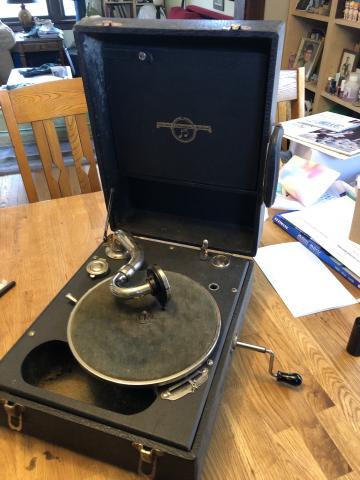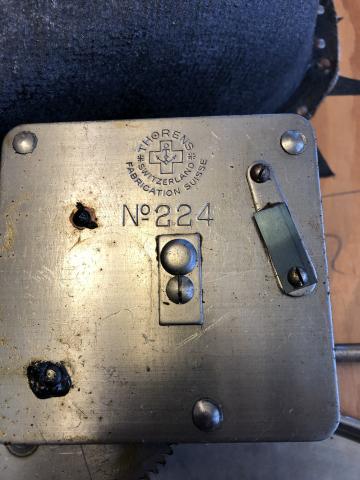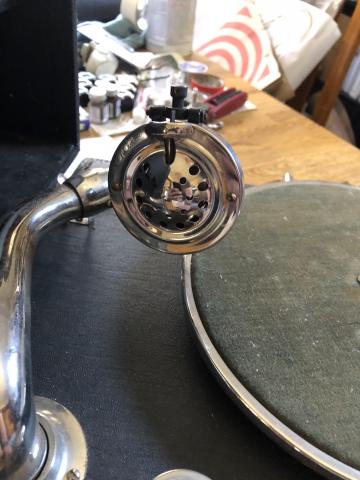I've been looking for one of these portable wind-up players for a while now. I have a couple of electric portables that work great and play a wider range of formats, but I also like the idea of being able to play records where we might not have electric power.
While trolling local estate sales, I saw this one pop up, and somehow it was still for sale when I arrived:
It seems like a pretty standard portable player from the 1920-30s, but I can't find an exact match for it online. Most similar Columbias have the brake and speed controls on the opposite sides, and the speaker sound hole exits at the rear of the unit. It's possible this was a European model or something, but I'm not really sure.
You can find similar units on eBay for $300-400, and (as far as I can tell) this isn't a particularly rare or fancy machine, but for $100 with all parts complete, I thought it was a bargain. On first test, the motor turned and the reproducer diaphragm looked intact, so I figured anything else could easily be replaced or fixed.
When I tested it at home it was obvious that the grease was pretty sludgy and it needed a good cleaning and lube, so I opened it up. Some of these players used pot metal for the tone arm and mount castings that would swell and crack over time, but this one seems to be a little better metal.
After removing the platter (slightly stuck on the taper fit) I got a look underneath and found this little brass number tag. I assume it's some kind of serial number, but apparently there's no surviving record of Columbia hardware from this era, so I can't do much with it. You can see the brake lever on the left, with the leather pad that presses against the inside edge of the platter to stop it from turning. The lever on the right is a speed control, which adjusts the speed of the governor in the motor.
With the 5 screws removed, the motor board lifted right out. Underneath the board you can see the formed cloth/fiberboard sound horn, which is a little soft on the bottom but fully intact, and the spring-powered motor. Look closely at the platter and motor and you might see a familiar brand.
The guts of the unit were made by Thorens, better known in modern times as a brand of high-quality turntables from the 1970s on. Apparently they made some of their own branded players in the early 1900s, but also supplied motors and assemblies to other makers as well.
The spring is a sealed box, but seemed to work fine, so I didn't open that up. All exposed bearing points were cleaned and related with fresh grease (gears) or sewing machine oil (pivots).
Next I checked the reproducer:
This is the orthophonic style, with an aluminum diaphragm rather than the mica diaphragms often seen on earlier home players. I have a mica reproducer in an adapter for my Edison player, and have rebuilt that one with fresh rubber gaskets. I took the cover off of this one, and found the diaphragm intact, and no obvious issues with the rubber, so left it alone.
Here it is on the first outing, to our back yard, playing records at the picnic table. It's surprisingly loud for such a small machine, even using soft needles. There's no volume control at all, short of covering the sound hole, which doesn't do much.
I did a little cosmetic work on the case after this to clean up the mildew powder inside the case lid and reglue some loose covering material, but it seems like a really solid little unit.






